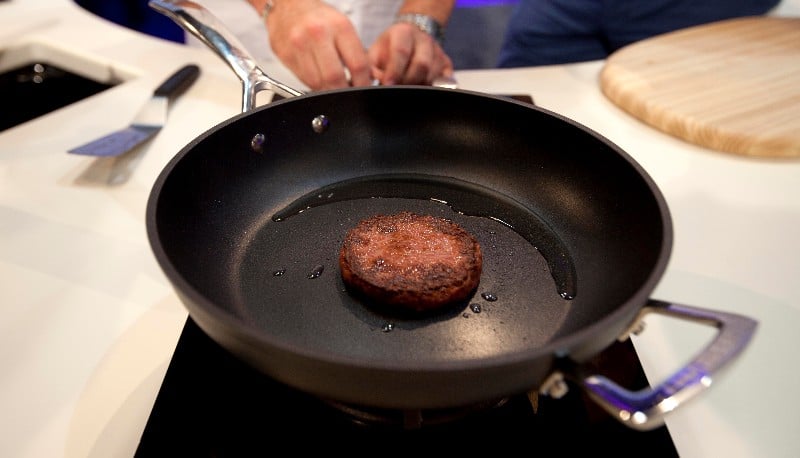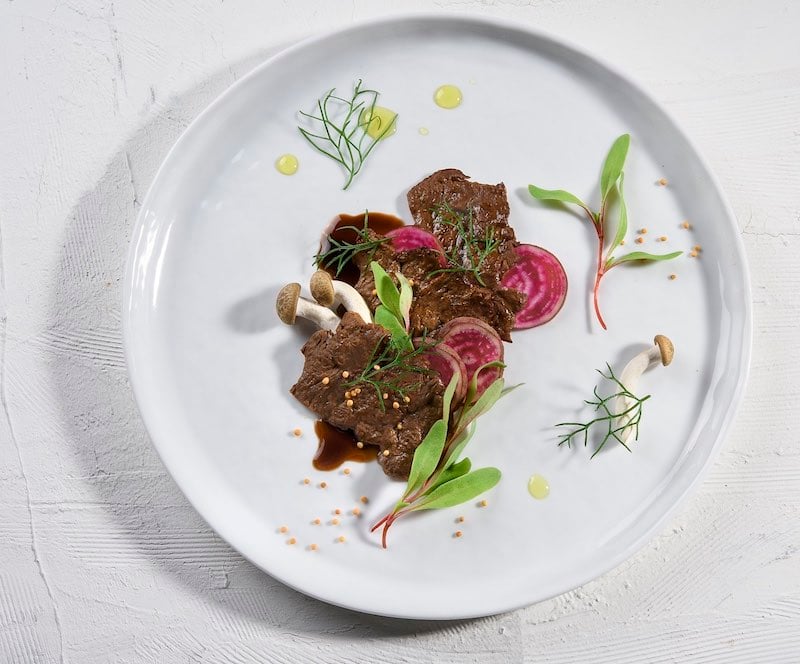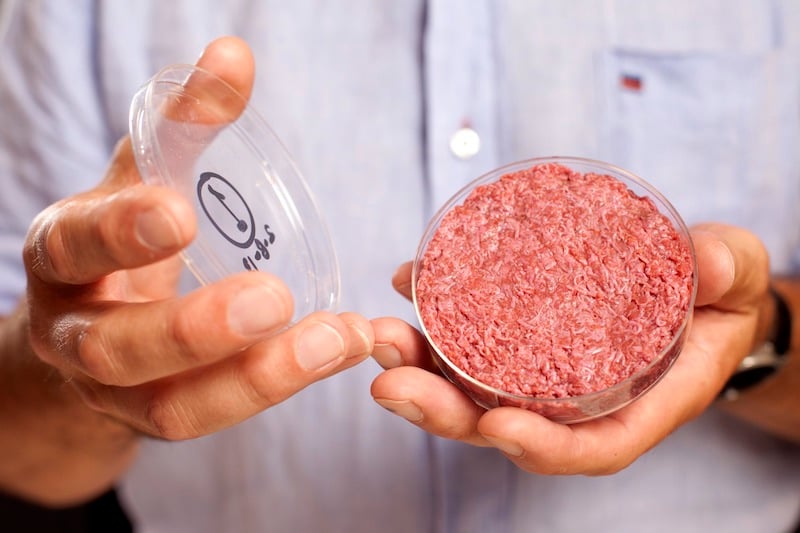Newsletter Signup - Under Article / In Page
"*" indicates required fields
Cultured meat promises to change the way we eat and help solve some of the big problems of a crowded planet. When will it be on our plate and how will this technology impact the world?
In a couple of years, your food might be served with meat that has been grown from animal cells in a factory rather than on a farm. Over the past decade, the field of cultured meat has evolved from just a few pioneers to a growing number of players working towards the common goal of making meat derived from animals a thing of the past.
We are now at a point where cultured meat has already hit the market; Singapore made history in 2020 as the first country to approve the sale of a cultured meat product. The approval in question went to cultured chicken manufactured by the US firm Eat Just for use in chicken nuggets.
With this building momentum, the commercialization of cultured meat in Europe and the US seems inevitable. To prepare for its arrival, it’s important to start thinking about the impact the technology will make, how it will be regulated, and whether people will actually want to eat it.
Why eat cultured meat?
“In time, I believe that cultured meat could fundamentally change the way the majority of meat is produced in Europe,” said Peter Verstrate, COO of the Dutch company Mosa Meat. Verstrate co-founded Mosa Meat with Mark Post, the scientist behind the world’s first lab-grown burger. The company aims to be one of the first to sell cultured meat in European restaurants and supermarkets.
“We will see a shift in the way production is organized from feedlots and slaughterhouses to cultured meat ‘factories,’” Verstrate explained. “Moving to this more efficient method of production would have many potential benefits for Europe, such as helping to reduce emissions of methane that contribute substantially to climate change.”

The environmental benefits of cultured meat are still very hard to predict. According to some estimates, the shift could not only reduce methane emissions but also decrease the use of water and land by over 95%. Growing meat directly from animal cells could also reduce the need of farmers to dose livestock with antibiotics, which contribute to the growing antibiotic resistance crisis, and with growth hormones, which are controversial for their impact on human health.
“Cultured meat is going to change the world,” said Daan Luining. Having worked in the development of the first cultured burger, he’s now CTO of Meatable, a Dutch cultured meat company. “It’s going to change how we view meat, how food is produced, what type of food is being produced, where it’s going to be produced, and what people will demand of it — on quality, on texture, on taste, on nutrients.”
When will it be on our plate?
Hot on the heels of Eat Just in Singapore, many other players including Mosa Meat, the Israeli firm Future Meat, and US-based Upside Foods expect to launch their own products around the world in the coming years. Investors are also showing heightened interest in these companies; Future Meat, for example, broke records with a €308M fundraise in December 2021.
“There’s a big hype, there is a race happening,” said Mercedes Vila, co-founder of the Spanish company Biotech Foods, which is now part of the global meat giant JBS. “In the past few months, new players have appeared; we’ve counted almost 20 companies in Europe, all of them of very recent creations. But I think we don’t compete between us — we are rather ambassadors for a new concept and it’s better not to be alone.”
The potential environmental benefits of cultured meat, however, might take a bit longer to materialize.
“We have billions of animals that are being raised and are being eaten,” said Luining. “If you can just reduce that by 10% or 20%, it would be massive on the environment, but we don’t expect that to be done within 10 years. The only thing that is now on our horizon is just stopping the growth of animal consumption. If we can just do that, it will be a huge win.”
Will it be affordable?
More than a year after the approval of Eat Just’s cultured chicken in Singapore, the firm has debuted the product at a partnered restaurant with a price tag of at least €13.80 ($15) per meal. Once other players enter the market, the economics and pricing might vary a lot depending on the type of meat and the technology used by each company.
Most cultured meat companies are trying to produce their own versions of beef. “Cattle are the least efficient links in production — pigs are twice as efficient, and chickens are four times more efficient,” said Verstrate. “Cattle also contribute the most greenhouse gases, including methane, which is 30 times more potent than carbon dioxide as a heat-trapping gas. And, cattle require the most natural resources, causing mass deforestation and loss of biodiversity.”
Beef is also one of the priciest meats. “Beef sells at two to three times the price of pork and poultry. With beef it will be easier to break even,” said Didier Toubia, co-founder and CEO of Aleph Farms. The Israeli firm was the first to create cultured steak, which is much more complex than producing processed forms of meat.

A number of companies are working on cultured fish, like Bluu Seafood in Germany, Wanda Fish in Israel, and the US-based Finless Foods and Blue Nalu. This type of meat might have lower manufacturing costs because culturing fish cells requires lower temperatures and therefore less energy to be produced.
For its part, Biotech Foods focuses on processed forms of food, such as sausages and ham. The company was acquired by JBS in 2021 and aims to bring its products to market in 2024.
The trick to driving costs down is scaling up production. “Making tissues in vitro has been around for a long time in regenerative medicine,” said Vila. “ What hasn’t been done before is [this process] at a large scale and at a price that a consumer can afford. It’s not the same as growing skin for a burns unit, which can allow for a higher price.”
Eventually, as cultured meat producers scale up, many predictions see the price becoming the same or even lower than that of conventional meat.
“Overall the cost of clean meat will continue to fall, just as it has since 2013,” said Matt Ball, formerly Media Relations Specialist at the Good Food Institute, a US non-profit supporting alternatives to animal meat. “This is relatively standard for new technologies. Today, you can buy an iPhone for a few hundred dollars, but the first one cost €2.3B ($2.6B).”
“Thick, complex cuts of meat such as prime rib will probably be more expensive than minced products like ground beef, at least for a while,” said Ball. “Once processes have matured, premium Kobe beef could be produced just as inexpensively as ‘generic’ beef. Bluefin tuna could theoretically be as affordable as carp or catfish.”
However, some critics don’t see the technology ever catching on. For example, traditional cultured meat such as Eat Just’s approved chicken relies on the use of fetal calf blood serum to grow cells. The medium — extracted during the slaughter of pregnant cows — is expensive and its use runs counter to the mission to eliminate animal cruelty. However, Eat Just and other firms like Mosa Meat are working on cheaper, synthetic sources of the medium.
How will it be regulated?
In order to sell cultured meat, the companies developing the technology need to comply with regulations around it. Outside of Singapore, however, regulations for cultured meat are still very new and remain a challenge for all players.
“We are fortunate in Europe that the regulatory pathway is much clearer than in the US,” explained Verstrate. “The EU’s novel food regulations have sped up the process so it may be faster than in the US, although we will have to see what happens.”
The European Food Safety Authority’s regulation on novel foods, which specifically includes cultured meat, establishes a process of around 18 months in which a company has to prove the product is safe.

“It’s not going to be easy,” said Luining. “There will be strict tests that you have to go through to prove that the product is safe. But I subscribe to that method because the thing that you should always keep in mind is public safety.”
In the US, the situation is still not as clear, but the FDA and the USDA have been actively discussing cultured meat. Given the engagement that they’ve shown, some believe the regulatory path will be quicker in the US than in Europe, but that remains to be confirmed.
In other locations, the technology is not as advanced and neither are regulations surrounding it. But some regions do accept products approved abroad, such as China, which will accept European regulatory approvals to commercialize certain products.
Will people want to eat it?
“Acceptance of clean meat seems to vary an awful lot between surveys. Some have shown as many as two-thirds of consumers saying they would eat clean meat, while others have shown as few as 16%,” said Chris Bryant, who researches acceptance of cultured meat at the University of Bath.
The wording used to conduct the polls seems to have a huge influence on poll results, but the concerns of respondents are the same. “Some people think clean meat won’t be as tasty as conventional meat, and others are concerned that it will be very expensive,” said Bryant.
“A lot of people are worried that meat grown from cells is unnatural, and could have negative consequences as a result. Of course, people rarely consider that today’s meat is far from natural! Animals are bred to grow unnaturally fast and large, and are pumped full of hormones and antibiotics to make them grow faster. Clean meat can actually avoid these practices.”
People, however, seem to be increasingly aware of the issues with traditional farming. For example, the year 2020 witnessed consumers rushing to buy plant-based meats, and investments going to companies developing meat alternatives shot up threefold.

“People are certainly interested in the possibility of avoiding the antibiotics, hormones, and diseases found in conventional meat,” said Bryant. “Consumers across Europe are also increasingly conscious of the environmental harm caused by meat production and animal cruelty is also becoming an important concern for many.”
Unsurprisingly, developers of cultured meat are confident that their product is wanted, and that acceptance will increase as cultured meat is no longer a novelty. Bryant believes that just seeing the product in stores will make many people lean towards eating it.
“Many things which are widely accepted today once seemed unfamiliar and strange; people were once wary of ice produced in freezers!” said Bryant. “Some data suggests that European consumers are a little more skeptical of the concept than Americans, but on the whole it seems that there will be solid demand for clean meat in European and American markets.”
“Clean meat has an easier path to wide acceptance than many technologies have had,” agreed Ball. “Think of in vitro fertilization! When faced with the possibility of ‘test tube babies,’ James Watson, Nobel Prize-winning co-discoverer of the structure of DNA, stated unequivocally that ‘all hell will break loose, politically and morally, all over the world.’ Now, 40 years later, no one gives it a second thought.”
“I am personally not especially concerned about consumer acceptance,” said Verstrate. “It will most likely take decades for production to be scaled up and for the price to become competitive with livestock meat, but once it does I think that most consumers will prefer a product that is better for the environment, animals, and their own health.”
What’s beyond cultured meat?
“Cultured meat is so new, it’s made in a way that people could only imagine just five years ago,” said Luining. “I always like to challenge people on thinking beyond when we have cultured meat. When we have created [meat] that is indistinguishable from the real thing, what’s next?”
One whole market that cultured meat could unlock is that of ‘personalized nutrition.’ Once we are able to fine-tune our ability to control the growth of meat, we could easily customize the nutrients of meat to a specific group of people, based on age, location, or health conditions.
“For example, here in the Netherlands, where it’s always dark, we could add vitamin D in your meat to supplement it,” explained Luining. He also envisions a future where meat is grown inside big cities, removing the need to transport it and making it easier to tailor to the needs of the people that live there.
These are long-term visions, but Luining believes it’s not too late to start working towards the future we want. A future where people are hungry for cultured meat.
Cover illustration by Elena Resko. Images via Mosa Meat, Aleph Farms, Meatable, and David Parry. This article was first published in December 2018; it has since been updated and republished.
Are you interested in sustainable agriculture and food R&D?







